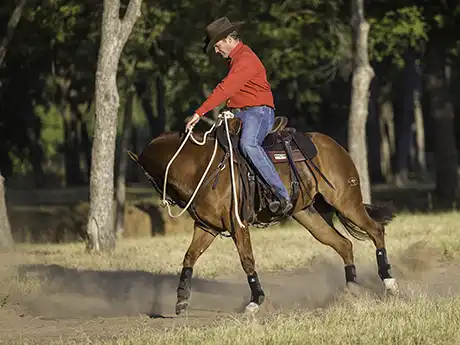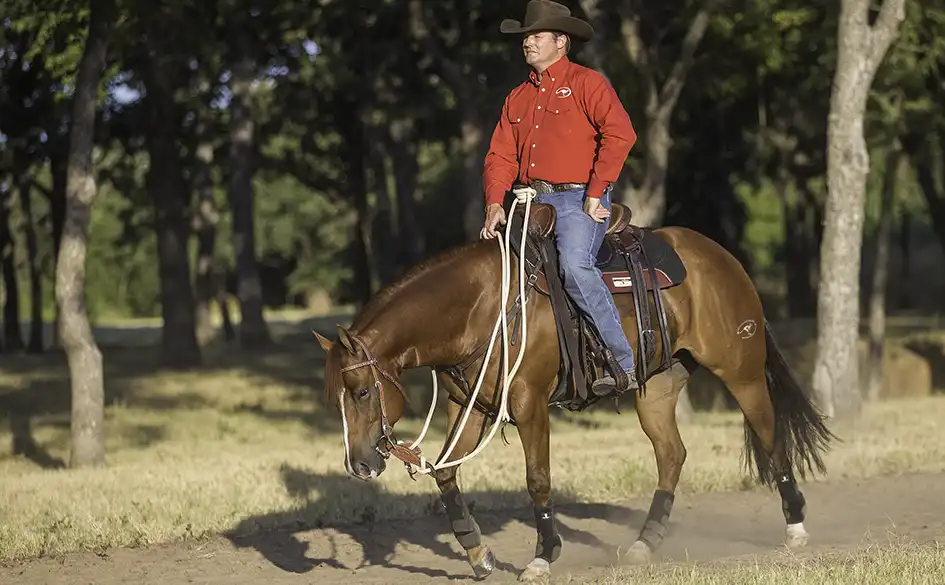Constantly telling a nervous horse to slow down won’t stop him from jigging; it’ll only make matters worse.
Jigging—that irritating half-prance horses fall into when they want to go faster and you won’t let them—is a symptom of nervousness or a lack of foundation. It’s one of the quickest ways to wreck an otherwise pleasurable ride. Rather than enjoying the time with your horse, you’re pitted against him in a speed war.
Before you can fix your horse’s problem, you first have to understand why he is behaving the way that he is. Is your horse hot and nervous because he’s in a group of horses, or is he just naturally hot and nervous on his own? Maybe you’ve taken him on a new trail and he’s uncomfortable in the strange environment.
Until your horse can ride down the trail while remaining relaxed and calm consistently by himself, don’t introduce him to a group situation. That’s one of the quickest ways to set a horse up to fail on the trail, because when horses are in a group situation their prey animal instincts take over and they switch to the reactive side of their brains. Horses have two sides to their brains: the thinking side and the reactive side. The thinking side is the calm, rational side we want our horses to use when we’re around them. The reactive side is the hot, nervous, panicky side of our horses that puts us in unsafe situations.
In order to get your horse to stop jigging and relax, you have to get him to use the thinking side of his brain. You’ll get the horse to use the thinking side of his brain by moving his feet forwards, backwards, left and right and always rewarding the slightest try. The more you move the horse’s feet and change directions, the more he’ll think and pay attention to you. If he’s paying attention to you, he won’t have time to think about getting nervous and jigging.
Directing the horse’s feet has the added benefit of giving you something to focus on as well. A lot of riders grow tenser and tenser the more their horses jig, certain the horse is going to take off at a gallop. Having a plan of action gives you something to focus on rather than your own nerves.
Direct Him with One Rein
The biggest mistake most people make with horses that jig is trying to convince the horses to slow down by pulling them back with two reins. The very last thing you ever want to do on a horse that is jigging, or on one that is using the reactive side of his brain, is to use both reins to try to stop him. The more you try to make a horse slow down by pulling back on two reins, the more upset and nervous he will get. Pulling back on both reins makes the horse feel trapped and claustrophobic, further driving his prey animal instincts to RUN! Using two reins to control the horse is only inviting resistance and makes the situation more dangerous.
Instead, when a horse panics and turns to the reactive side of his brain, use only one rein to control him and concentrate on getting him to use the thinking side of his brain by doing lots of changes of direction. This puts his excess energy to good use and convinces him that attempting to jig is not worth the extra work you give him.
The moment you feel your horse pick up that halfwalk, half-trot pace, take him up on his offer to move forward. “If you want to speed up, let’s go!” you’ll say to him. But instead of letting him build speed as he goes down the trail, you’re going to bend him around in a circle. Use your inside rein and leg to direct him in a circle. Go around two or three circles, and then bend him down the other way. Or, trot him in a series of serpentines, constantly asking him to reshape his body and move his feet. If you can, use the environment around you to redirect the horse’s feet—serpentine him around trees and bushes, circle around a rock and roll him back into it every couple of circles, etc.
When the horse relaxes—he drops his head and neck and feels soft in your hands—let him slow down to a walk. Put him on a big, loose rein and dare him to jig again. If you did a good job of directing your horse’s feet, he’ll readily slow down to a flat-footed walk.


If your horse jigs, redirect his feet. Here and opposite, I’m guiding my horse in a series of serpentines.
If he gets jiggy again, immediately put his feet to work. How you direct his feet isn’t important. The key, however, is to redirect the horse’s feet. You don’t want to do it so aggressively that you scare the horse. A horse that’s jigging is nervous; thumping his sides with your spurs or jerking on the reins will only make him more reactive. However, if you move him around in a cutesy, cutesy western pleasure jog, you won’t accomplish anything either. There’s a fine balance there. You want him to sweat and realize that walking on a big, loose rein is by far the better option. Jigging only results in having to work hard and sweat.
It may take a few repetitions of this before your horse settles down and calmly walks down the trail. If you’re consistent, the lesson will take hold.

When the horse relaxes, let him slow down to a walk and put him on a big, loose rein.
The Bottom Line
A horse has to be respectful, calm and using the thinking side of his brain in the arena (or a controlled environment) before he will behave the same on the trail. If you can’t walk, trot and lope your horse on a loose rein and bend and soften him in an arena, you won’t be able to do it out on the trail either. The lack of control you have of your horse in the arena will only get worse when you take him outside.
Most trail problems are a result of a lack in the horse’s foundation that happens to be showing up when the horse is taken out on a trail ride and jigging is no exception. Before you venture out on a trail ride, have your horse listening to you in the arena first so that you’ll have the tools you’ll need if he misbehaves on the trail.
Success Tips:
Don’t set your horse up to fail.
The top three reasons why horses jig are: 1) he’s fresh and full of pent up energy, 2) he’s barn sour and trying to get home faster, and 3) he’s trying to get to the front of a group. If your horse is jigging because he’s fresh, it means you did a poor job of preparing him for the trail ride. You should have knocked his pent up energy out of him with groundwork exercises like Lunging for Respect Stage Two. Keep something in mind, it’s unfair to not ride your horse all week and then pull him out of his stall on Saturday, throw the saddle on him and think you can ride off down the trail like John Wayne. Horses require maintenance.
If he’s barn sour and trying to race home, use the solution I discuss in the “Sweeten a Barn-Sour Horse” chapter. Basically, you’ll allow the horse to trot home, but once there, instead of unsaddling him like he wants, you’ll put his feet to work.
If he’s trying to catch up with a group of horses, follow the steps I describe in the “It’s Not a Race!” chapter. But be smart about when you introduce your horse to riding in a group. Don’t put him in that situation until he can handle riding on the trail on his own.

If your horse is fresh, practice some groundwork with him before riding him to knock some of the energy out of him.
Ride offensively.
Most trail riders put their horses on big, loose reins and walk for two or three hours while they gab with their buddies. It doesn’t take long for the horses to get bored. Horses are just like kids in that way; if you don’t give them something to do, they’ll find something to do and you can bet it won’t be something positive for you.
Don’t put your horse on autopilot for hours at a time and wait for him to develop a problem. Even if he’s behaving well, every once in a while put his feet to work anyway. Remind him that his job out on the trail is to listen and pay attention to you. Then put him back on a loose rein and ask him to walk. I want my horses to think that walking on a loose rein is a reward and I want it to be something that they appreciate. But if all you ever do is walk your horse down the trail, he’ll get bored with it and look for more interesting things to do. Give your horse a reason to appreciate walking.

Master Your horsemanship Skills
Like these tips? Join the No Worries Club and hone your skills with thousands of hours of Clinton’s easy, step-by-step method horse training videos.



